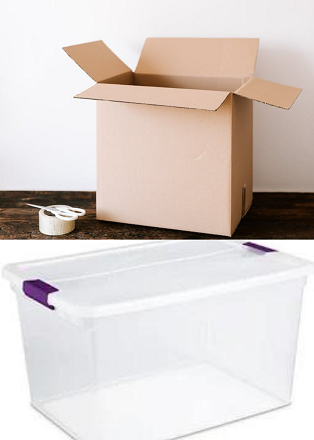 If you’re asking the question, should I use plastic containers or cardboard boxes for storage, the answer to this question is, that it depends. Each resource has pros and cons just like any decision that you make on a daily basis.
If you’re asking the question, should I use plastic containers or cardboard boxes for storage, the answer to this question is, that it depends. Each resource has pros and cons just like any decision that you make on a daily basis.
They each have scenarios which work better for their respective materials, so let’s explore scenarios that work better for storage with plastic containers and cardboard boxes.
Cardboard Boxes
Pros:
- Cardboard boxes are typically used for temporary storage due to the material they are constructed from.
- Moving is at the top of the list of scenarios for use since it’s a temporary storage solution.
- Shipping items is another scenario that works well due to the temporary nature of storage.
- Low-cost storage option with varying sizes available.
- They can be recycled by way of re-use or at their end-of-life via recycling facility or burned in a contained firepit.
Cons:
- They aren’t good for long-term storage especially when stored in a non-climate-controlled environment such as a garage or attic. The constant changing temperature and humidity will break down the material over time.
- Critters can easily chew their way in and destroy the contents quickly.
- Unless labels are used to identify the contents, it’s difficult to know exactly what lives in the box.
- No protection for the contents when/if they come in contact with water.
Plastic Containers
Pros:
- Plastic containers, due to the material they are constructed from, are more suitable for long-term storage.
- Various sizes and colors suitable for each application.
- Suitable for delicate contents and protection from the elements.
- Snap on lids provide protection from bugs and other invasive creatures.
- Constructed with material that won’t easily break down over time.
- Clear containers provide an ‘at-a-glance’ vision of contents with or without labels.
Cons:
- Colored containers do not provide the ‘at-a-glance’ vision of contents and need labels.
- Some can be a little pricey depending on the type of plastic container you choose.
- Plastic containers, not all, but some are not able to be recycled. None of them are biodegradable naturally and those that can be recycled need to go to a recycling facility.
- They can absorb colors and smells over time.
This post is intended to provide the pros and cons of each of these storage options for you to make an informed decision of the choice of materials for your storage needs. I’m sure it’s not all-inclusive but should provide a starting point for your research.



Leave A Comment